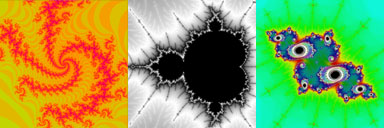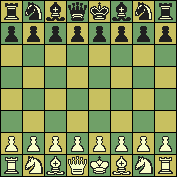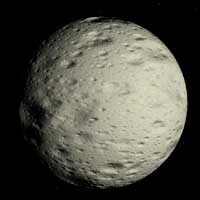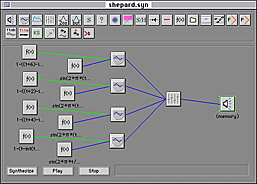
Note: Actually, ALL this stuff is pretty ancient. I haven't put new software on here in about 4 years, and I'm back on a Mac now... jbum, march 2008
I hope you enjoy the software!
Click here if you know what you're looking for and you just want to see the files.
 |
Mandel Zoom (Windows) is a beta version of a new fractal explorer I am working on. Unlike many
Fractal programs, Mandel Zoom will enable you to zoom in and out of the Mandelbrot set in real time. The program can produce a bewildering variety of
beautiful images and is quite fun to play with. Check it out!
|
Cheese Toast III: Attack of the Scones (Windows) is a new version of Cheese Toast that I have been working on more recently (2003-2004). This version takes advantage of 3D acceleration on modern graphics cards and features new graphics and sounds.

|
Plywood, version 1.7.2 (for Windows) is the latest version of my home-grown
computer chess program. It plays against humans on the Free Internet Chess Server and has
a FICS rating of about 2150 (not that great as chess engines go, but far better than my own 1000). If you drop by FICS,
say hi to Plywood (or jbum) - I might be online watching plywood's games.
If you'd like to run Plywood on your own computer, you'll also need a copy of Winboard (shown at left), which is a standard interface for running chess-engines and you will have to figure out the arcane process of reconfiguring Winboard (hint: edit the winboard.ini file). If this sounds complicated, I suggest you take up checkers. |
|
In 2001, I was playing a lot with Renderman, using the (once) free BMRT renderer.
Some of my Renderman shaders can be downloaded at renderman.org.
I also wrote some OpenGL screen-savers. These run on Windows and require a reasonably fast machine (>= 300 Mhz) with a graphics accelerator card. To install these, drop them in your "System" or "System32" folder (where your other screen-savers are kept. |

|
Sproinks (for Windows) may be the prettiest OpenGL screensaver I've done to date. It uses layered noise and radial blur to get some interesting plasma-like effects. It looks sort of like a cross between a tie-dye shirt and the aurora borealis.
Space Rangers (for Windows) is an OpenGL screen saver that shows a busy highway in space, as imagined in the 1950s. Cigar shaped rockets, wobbly planets, and a flying saucer. Space Rangers periodically displays in black and white with simulated film dirt.
Yggdrasil (for Windows) is an OpenGL screen saver that depicts the mystical earth-tree of Norse myth. Yggdrasil's branches support the heavens, and its roots go into the underworld. Yggdrasil acts like a clock - it's lighting is based on you local time. Yggdrasil also brings CPUs to their knees.
More of my screensavers are available at KRAZYDAD (my new website)...
Pixel Magic 1.0a (for Macintosh) is a stand-alone version of my Photoshop filter "Expression" (that is photoshop is no longer required!). Think of it as an exploratory graphics program for the mathematically literate. It creates images by computing the results of mathematical expressions which you supply. It can be used to create some extremely interesting and beautiful special effects such as Fractal Zooms, animated clouds and many others. I use it mostly to create animated textures for 3D modeling but it has a number of other uses.
This type of software is perhaps too artistic for mathematicians, and too mathematical for artists. If this description intrigues you, then check it out!
I also have a Windows version, e-mail me if you want it.

| 
| 
| 
| 
| 
| 
|
Syd (formerly SoftSynth) (for Windows and Macintosh)
is a music synthesis program in which you can "patch" modules together with patch cords to produce
interesting sounds. It is available for both Mac and Windows.

|
I wrote Syd so I could reproduce some of the sounds produced by the Buchla 200 analog
synthesizer I used to play with at CalArts in the early 80's. It has since evolved
into an interesting computer-music tool in its own right. Source code available upon request. |
Here's a Windows version of Orville (not as fully featured) for you to check out!
Here's a Palm Pilot version of Orville (nearly brain-dead) for you to check out! And here's a similar trick I wrote that works using plain-old HTML. Have fun!
If you're interested in the CD+G format, here's a document that explains how I wrote the program and if you're really a masochist here's the source code.
Update: David Cotter is working on an OS X compatible CD+G Player, called KTunes, which incorporates some of my old source code. Check it out!
Cheese
Toast (Macintosh) is a tongue-in-cheek asteroids-like game I wrote back in 1991
to learn a little about sprite programming. If you look really closely,
you'll see my head (circa 1991 with a little more hair!) floating around in
space. Source code is included.
Son of Cheese
Toast (Macintosh) is a sequel to Cheese Toast that I worked on in 1995. It has better
graphics, larger sprites, and some new bad guys, including the evil english muffin
twins, Nook and Cranny. Source code is not included.
Cheese
Toast III: Attack of the Scones (Windows) is a new version of Cheese Toast that I have
been working on more recently (2003-2004). This version takes advantage of 3D acceleration
on modern graphics cards and features new graphics and sounds.
HexEdit 1.0.7
(Macintosh - see below for latest version) is a programmer's Hex editor - for viewing and editing files in
a hexdump format. I have found it to be indispensible in my work, primarily
as a tool for analysing the contents of binary files. Also occasionally
useful for those Internet downloads you can't unpack and you want to
figure out "what the hell IS this thing???" Source code is included.
Note: The OUT OF DATE version offered here is the last version of HexEdit that I worked on personally. In recent years, other programmers (esp. Lane Roathe and Nick Shanks) have taken up the mantle and produced enhanced versions which add features, fix bugs, and run in a more stable manner on more recent versions of Mac OS. You can find the latest version of HexEdit (1.7.5 at last check) here.
Photoshop Expression (Macintosh) is a multi-purpose PhotoShop filter for the mathematically
literate. It creates images by computing the results of mathematical
expressions (thus the name) which you supply. It can be used to create
some extremely interesting and beautiful special effects such as Fractal
Zooms, animated clouds and many others. I use it mostly to create
animated textures for 3D modeling but it has a number of other uses.
This program is perhaps too artistic for mathematicians, and too
mathematical for artists. If this description intrigues you, then
check it out!
Here's the 3.0b version for 68k macs and here's the 3.1 version for PowerMacs.
Softimage Plugin (Macintosh) is a Photoshop filter for importing and exporting images
from the Softimage format. A useful utility for those of you forced to use
those expensive boat anchor SGI machines. :)
That's it for now! If there's something else you'd like to see here,
send me some e-mail.